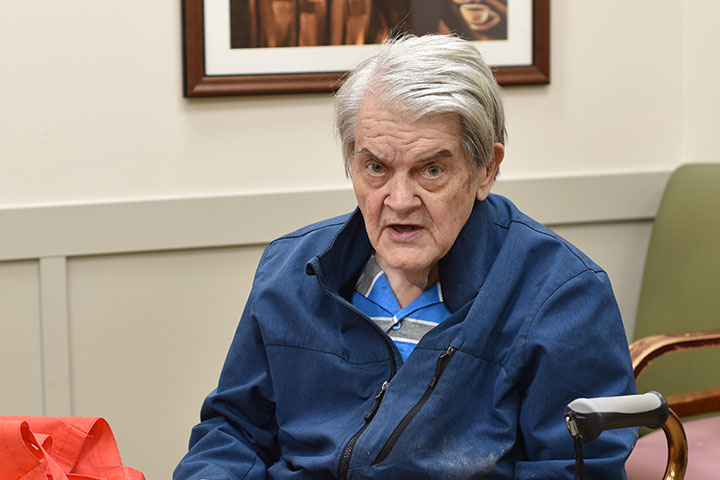Paying tribute to a great figure
by John Henderson
This article was reproduced from CHESS Magazine January/2018, with kind permission.
Born on 4th December 1937 to a Polish mother and an Italian father, Bill Lombardy grew up in Hunts Point in the South Bronx, New York, where he was taught to play chess at the age of 9 by a neighbourhood friend. He soon took to the game and began frequenting chess clubs across the city, including a 1954 visit to the Manhattan Chess Club, where he first befriended an 11-year-old Bobby Fischer, and both standout prodigies were prepared for chess stardom by legendary chess coach Jack Collins.
However, during an era that witnessed Fischer explode upon the scene, Lombardy found himself having to be content to play second fiddle with his teenage talents never being fully recognised — and although he was forever overshadowed by Fischer, Lombardy seemed quite content to be a privileged eyewitness to somebody transforming the sport forever, and recently that friendship and association was immortalised in a Hollywood movie.
"It’s kind of like Mozart and Salieri," once said Frank Brady, former president of the Marshall Chess Club and Fischer’s biographer. "Lombardy might have been the greatest of his generation if Bobby hadn’t come along." And Brady wasn’t far from the truth here. Being Fischer’s senior by six years, it was Bill who proved to be the first to usher in that exciting new generation of U.S. chess stars, only to then being eclipsed by Fischer and becoming his close confidant as he reached the summit.
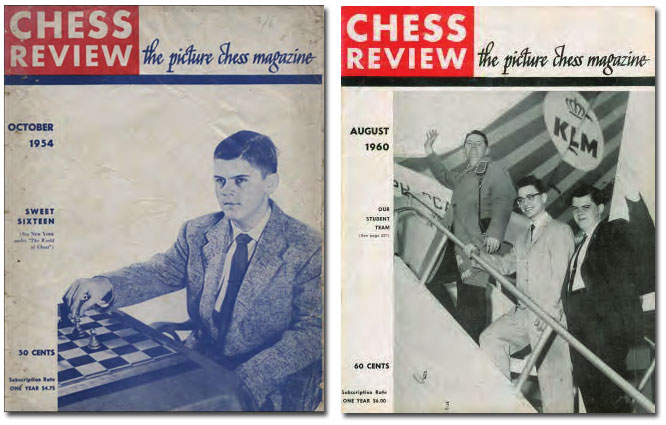
Bill Lombardy’s first front cover for ‘Chess Review’ in October 1954, after becoming the youngest-ever New York state champion in 1954. On the right Jerry Spann, Raymond Weinstein, and Bill Lombardy on their way to the historic 1960 World Student Team Championship | Photos: U.S. Chess Federation
In 1957, in Toronto, Canada, Lombardy became the first American to win the World Junior Chess Championship title, and doing so with a perfect score of 11/11, a record that still stands today. Three years later, in a defining moment, he led the United States to an historic gold-medal winning performance ahead of the strongly-favoured Soviet Union in Leningrad (now St. Petersburg) in the 1960 World Student Team Championship. In inspired form and undefeated on top board with a tally of 11 wins (and two draws), Lombardy memorably beat future world champion, Boris Spassky, in a key game that not only led to the capture of the title, but also caused consternation for Spassky, who became the scapegoat for the humiliating Soviet defeat.
This gave the Americans their first and only team victory over the Soviets and started a Cold War rivalry over the chessboard that would challenge the one also in space. That same year, 1960, Lombardy was a standout performer playing second board behind Fischer and helped the U.S. team take silver behind Russian gold at the Leipzig Olympiad. He also qualified from the 1961 U.S. Championship to the 1962 Stockholm Interzonal, which Fischer went on to easily win – but he declined his Interzonal place and this signalled the end of any further chess ambitions, as by now he had made the decision to become a Catholic priest. He entered the seminary in 1961, was ordained in 1967 and worked in the Bronx, but left in 1973, complaining of unscrupulous pastors who objected to his playing chess. When he left the priesthood, he married, had a son, but soon divorced.
In 1972, as Fischer went on to challenge Spassky for the world title, the American recruited Lombardy to be his second and confidant during the match in Reykjavik. However, despite Fischer sacking Lombardy as his chief trainer during the adjournment of game 13 and replacing him with Lubosh Kavalek for the remainder of the 21-game series, there was no real animosity between the two. And in 2014, a Hollywood movie of that epic Cold War duel was released, Pawn Sacrifice, with A-listers Tobey Maguire and Liev Schreiber in the leading roles as Fischer and Spassky, with Lombardy’s character portrayed by Peter Sarsgaard.
In the latter years of William J. Lombardy, the endgame of his life tragically played out much like one of the many old masters from a bygone era we have all read about, who had sadly fallen on hard times with ill health, and were to die in penury. It all started to go tragically wrong for Bill in 2016 with many stories appearing in the media, including a major feature in the New York Times, about a protracted legal dispute with his landlord over rent arrears for his cherished sixth-floor New York red brick apartment in Stuyvesant Town.
He’d lived there for almost 40 years, initially moving there in 1977 to help take care of Jack Collins, his former coach. But the last decade proved to be problematic, with accusations that the building’s management were deploying tough tactics with tenants simply to clear the building located in a prime piece of NY real estate – in order to make way for a new multi-million dollar development. Bill was one of the last to leave the building, but not before 18 court cases and many subsequent appeals, and then finally being evicted in early 2016 with rent arrears of $27,124.82, which he strenuously denied he owed.
Many have commented that Bill often created ‘roadblocks’ for himself, having a strong will and often being too proud to accept help when it was being offered to him. But now finding himself homeless, and his health plagued by chronic heart problems, he initially rejected offers of help and support, only for things to get further complicated after he was seriously assaulted and had to spend months in hospital before finally discharging himself, and since the early spring precariously living life day by day.
Bill attended the U.S. Open in Norfolk, Virginia, in early August, then spent a few days in Chicago before moving on to teach at a chess camp in Burlington, Iowa, on the Mississippi river. On the spur of the moment he hopped on the California Zephyr heading west and ended up at the railway terminus in Emeryville (next to Oakland). He then took a cab to Redwood City on the Peninsula between Silicon Valley and San Francisco, there spending the best part of a week staying in the Europa Hostel for the homeless.
He finally accepted the offer of a friend, Richard Hack, to stay temporarily in his small studio apartment, which was handily located half a mile or so from the Mechanics’ Institute Chess Club. And being so near to the fabled SF club, he got a gig giving lessons and lectures to the club members that at least put $1500 in his pocket – but typically of Bill, rather than get a hotel, he opted instead to stay at a 24-hour McDonald’s hamburger bar and then slept for a period on the floor at the Mechanics’.
But after a few days roughing it, and with his health noticeably declining, Bill accepted an offer to stay with another friend, Ralph Palmeri, in Martinez, California, where he at least had some respite by spending the last ten days of his life in his own room, with a laundry service and a well-stocked fridge. And there, on 13th October, 2017, he died peacefully in his sleep of natural causes.
In his lifetime, Lombardy, a very private and stubbornly principled person, twice notably refused approaches from the powers that be to be inducted into the U.S. Chess Hall of Fame. Paradoxically, in death, now there’s no reason for him not to be inducted, and I’m sure he’ll soon rightly be taking his place in the Hall of Fame, right up there alongside Bobby Fischer and the many other chess stars of his generation.
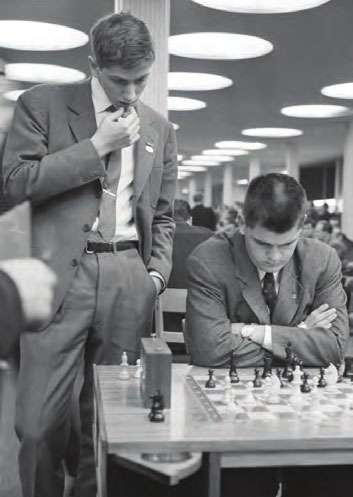
Bobby Fischer is enrapt as he watches his American team mate Bill Lombardy ponder his 15th move, in his game against Radovici at the Leipzig Olympiad in 1960 | Bundesarchiv, Bild 183-76052-0053 / Kohls, Ulrich / CC-BY-SA 3.0 via Wikimedia Commons
As previously mentioned, Lombardy was in his pomp in the early Sixties, so must look towards this period to pay tribute to him through his games. And for me, his best game was against Lajos Portisch, at Leipzig 1960, that immediately made an impression on me as a young kid, when I first came across it in one of my earliest chess books, Chess With the Masters, by Martin Beheim – though the English version was edited, revised and greatly improved with many new additions by Leonard Barden, who had the good sense to included this game after witnessing it at firsthand while in Leipzig.

[Event "Leipzig Olympiad"] [Site "?"] [Date "1960.??.??"] [Round "6"] [White "Lombardy, W."] [Black "Portisch, L."] [Result "1-0"] [ECO "A37"] [Annotator "John Henderson"] [PlyCount "115"] [EventDate "1960.??.??"] [SourceTitle "Chess 2018 #01"] 1. c4 c5 2. g3 Nc6 3. Bg2 g6 4. Nc3 Bg7 5. a3 a6 6. Rb1 Rb8 7. b4 cxb4 8. axb4 b5 9. cxb5 axb5 10. Nf3 Nh6 ({In the English Symmetrical, Black can't simply mirror White's moves, as eventually White's opening move advantage will become a telling one, such as} 10... Nf6 11. d4 d5 12. Bf4 Rb6 13. Ne5 {and White already has the makings of threatening attack.}) 11. e3 d5 12. Ne2 O-O 13. O-O e5 14. d3 f5 15. Qb3 Nf7 {At first sight, Portisch seems to have an excellent position - but appearances can be deceptive. The problem is that Black's pieces are not positioned actively enough to support his advanced pawns, and Lombardy now takes full advantage of this by beginning some undermining manoeuvres.} 16. Ne1 $1 Ne7 17. f4 $1 Be6 18. fxe5 Nxe5 19. Nf3 $1 {Lombardy has successfully broken down Portisch's once impressive pawn centre, and now he's going to heap pressure on the pawn weaknesses on d5 and b5.} Nxf3+ 20. Bxf3 Bf7 21. Nd4 Re8 ({The knight has a powerful outpost on d4, both attacking and blockading Black's weak pawns - and playing} 21... Bxd4 22. exd4 {is no solution, as all it will do is gift White control over the dark-squares with his bishop swiftly coming to f4.}) 22. Bb2 Qb6 23. Kh1 h5 24. Ra1 Ra8 25. Rxa8 Rxa8 26. Rc1 h4 27. Qc3 Rc8 28. Qd2 Rxc1+ 29. Qxc1 hxg3 30. hxg3 Qd6 31. Kg2 Be8 {If anything, the reason Portisch gets seriously outplayed in this game is allowing the exchange of rooks, as he needed them later to counter attack. As it is, White's minor pieces now dominate the board.} 32. Nc2 $1 {The forced exchange of bishops only helps White, as his queen will eventually come to d4 to put heavy pressure on d5.} Bxb2 33. Qxb2 Nc6 34. Qb3 Bf7 35. Qc3 g5 36. Nd4 $1 {Despite the reduced material, there's no respite for Portisch, as the ending is better for White because Black's pawns are separated and more vulnerable to attack.} Nxd4 37. Qxd4 g4 38. Be2 Qh6 39. Bf1 Qa6 40. Kf2 Kh7 41. Qc5 $1 {The quiet moves are almost often the most lethal of killers. And here, with 41 Qc5, Lombardy's simple queen move now simultaneously hits b5 and d5 - and Portisch can't avoid the loss of one of the pawns.} Qa2+ {Portisch has - rightly - worked out that he can't defend this position, so he goes for broke by making his queen as menacing as he can, hoping he can pressure his opponent into believing there could well be a perpetual. Lombardy has this all covered, but in such situations, often a suddenly active queen can put pressure on your opponent that can lull him or her into believing there could well be something that there isn't.} 42. Be2 Qb1 43. Qxb5 Qh1 44. Qb8 {Having successfully picked off the b-pawn, and in the process creating a powerful passed b-pawn for himself, Lombardy has double-checked that Portisch's checks lead to nothing. The rest is simple.} d4 45. Qe5 Kg6 46. Qd6+ Kh7 47. Qf4 dxe3+ 48. Kxe3 Qc1+ 49. Kf2 Qxf4+ 50. gxf4 {With opposite-coloured bishops, this would be a draw, but not with bishops of the same colour.} Bd5 51. b5 Kg6 52. d4 Kf6 53. b6 Bb7 54. d5 $1 {The whole point to Lombardy's play: the pawn cannot be captured with 54...Bxd5 as 55 Ba6 wins the bishop. But not only that, the push with 54 d5 cuts Portisch's king from easily coming across the board, giving White the winning plan of Bd3xf5xg4 and Bf3, forcing the exchange of bishops and an easily won king and pawn ending.} Ke7 55. Bd3 Kd6 56. Bxf5 Kxd5 57. Bxg4 Kc5 58. Bf3 1-0
Despite my own personal choice, one of the most published games of 1960 is this defeat of Boris Spassky that’s universally recognised as Lombardy’s best-known game. However, what was worse for the Soviets on their home turf, was that Lombardy, with an astonishing unbeaten score of 12/13 (92%!), also stole the limelight by winning the individual gold medal for the best top-board performance — and his famous double gold-medal feat over Spassky was to have serious repercussions for the future world champion.
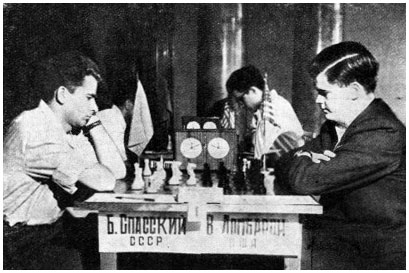
Boris Spassky and Bill Lombardy in 1960 | Source: Olimpbase.org
As author Andrew Soltis mentions in his book Soviet Chess: 1917-1991, "After Spassky lost a highly publicised game to the American William Lombardy on first board in the 1960 Student Olympiad he was left off the 1961 team and was eventually suspended from foreign travel three times. He was replaced at the last minute as a Soviet invitee to Hastings 1962-63 — a typical Sports Committee humiliation."
And, indeed, when Spassky stayed with Soltis during a visit to New York in the 1980s, he confirmed that he was the one who was singled-out and punished by the Soviet authorities for that defeat to Lombardy: “My nervous energy was completely destroyed for three years”, confirmed Spassky of this period in his life.

[Event "World Student Team Ch., Leningrad"] [Site "?"] [Date "1960.??.??"] [Round "?"] [White "Spassky, B."] [Black "Lombardy, W."] [Result "0-1"] [ECO "B94"] [Annotator "John Henderson"] [PlyCount "58"] [EventDate "1960.??.??"] [SourceTitle "Chess 2018 #01"] 1. e4 c5 2. Nf3 d6 3. d4 cxd4 4. Nxd4 Nf6 5. Nc3 a6 6. Bg5 {In his early days, Spassky cut a dashing D'Artagnan figure who would always play the sharpest lines. And here, against the Najdorf, they don't come any sharper than 6 Bg5.} Nbd7 $5 ({The main line, as favoured by Fischer, runs} 6... e6 7. f4 {etc, but in those sans computer pioneering days of the Najdorf, Lombardy plays a less popular continuation, perhaps hoping to catch Spassky out - and his ploy works. }) 7. Bc4 Qa5 8. Qd2 e6 9. O-O {At the time, this was a pet line of Mikhail Tal, and he was the trendsetter during this period of chess. Some might prefer queenside castling and sharp play on both sides of the board, but at the time, praxis showed that Tal's more modest option was very effective.} Be7 10. a3 { Far too timid.} ({Much better was simply 'getting on with it' with} 10. Rad1 { that had held up well for White previously.}) 10... h6 11. Be3 Ne5 12. Ba2 Qc7 ({The Najdorf can become complicated very easily and very quickly, and here Lombardy also had the double-edged option of} 12... Neg4 $5 13. f4 Qh5 14. h3 Nxe3 15. Qxe3 g5 {with complex play. However, Lombardy had easily equalized in the opening, and as the saying goes, 'equalizing' in the Najdorf often means Black is better. As such, he goes for the solid option, leaving Spassky pondering just how he's going to break down his opponent's resilience.}) 13. Qe2 b5 $1 {A very natural Sicilian Najdorf move that not only claims a little real estate on the queenside, but also heaps pressure on White's e4-pawn with a follow-up of ...Bb7.} 14. f4 Neg4 15. h3 Nxe3 16. Qxe3 O-O {There's nothing much in it, but, if anything, Black has emerged from the opening with the slightly better and more solid position.} 17. Rae1 ({Perhaps the better option was} 17. Rad1 {, but Spassky seemed intent on pushing forward with e4-e5;}) ({ and as Lombardy notes in his own annotations to this game, the speculative} 17. e5 $6 {backfires due to} dxe5 18. fxe5 Nd7 19. Rxf7 $2 Rxf7 20. Bxe6 Qxe5 $1 21. Bxf7+ Kxf7 22. Qf3+ Nf6 23. Qxa8 Qxd4+ {with a winning advantage.}) ({ Also too early is the other push with} 17. f5 e5 18. Nf3 d5 $1 {and the game is suddenly opening up to Black's advantage.}) 17... e5 18. Nf5 Bxf5 19. exf5 d5 $1 {Taking full advantage of the major threat of ...Bc5, pinning queen and king.} 20. Qxe5 $2 {In a critical position, Spassky uncharacteristically losses his nerve - and perhaps his judgement was clouded by the fact that the Soviets began to realise that they could be in danger of losing to the USA in a match they simply had to win to take gold.} ({Correct was} 20. Kh2 {, as pointed out by Lombardy after the game. Now, if} d4 21. Qxe5 Qxe5 22. Rxe5 Bd6 23. Nd5 $1 Bxe5 24. Ne7+ Kh7 25. fxe5 Nd7 26. Re1 Nb6 {, the game is still complex, but it is doubtful whether White has enough here to try to force a win.}) 20... Bd6 21. Qe2 Bxa3 $1 22. Nd1 $2 ({Such are the vagaries of playing in team competitions. Realising he needed to win, Spassky perhaps felt he had to 'gamble' here with 22 Nd1, rather than having to go down the easy line for Black of} 22. Nxd5 $1 Nxd5 23. Bxd5 Qc5+ 24. Kh2 Qxd5 25. bxa3 Qxf5 26. c4 $1 { , immediately fixing the pawn structure; though this major piece endgame will ultimately trade down to an easy draw. The rub here is that White has nothing at all here to work with - and this probably explains Spassky's rationale for gambling with what ultimately turns out to be a risk too far instead of playing for the draw.}) 22... Rae8 $1 {Lombardy now finishes off his illustrious opponent with great energy and precision - an energy and precision that was lacking from Fischer when he played Spassky before 1972.} 23. Qf3 $2 { Things go from bad to worse now for Spassky.} ({His only hope of trying to hang on here was with} 23. Qd2 $1 Rxe1 24. Rxe1 Bd6 {, although even here he's suffering badly.}) 23... Bc5+ 24. Kh1 Rxe1 25. Rxe1 Qa5 $1 {The obvious move, winning a piece, that Spassky likely overlooked when he opted for 23 Qf3.} 26. Nc3 b4 27. Nxd5 Qxa2 28. Nxf6+ gxf6 29. Qc6 Qc4 0-1
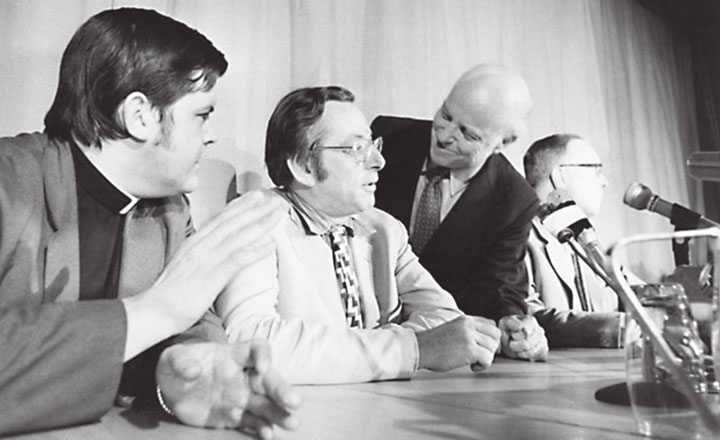
Bill Lombardy, left, at a news conference at the world championship in 1972, with Paul Marshall, centre, a lawyer for Bobby Fischer, and Fred Cramer, Mr. Fischer’s representative.
Another who was also a part of that golden generation for U.S. chess was Larry M. Evans, and here, in an almost forgotten gem from the American chess scene, Lombardy wins the brilliancy prize as he spectacularly thwarts his opponent’s brilliant attempted swindle in a wild game from the 1971 U.S. Open in Ventura, California.

[Event "US Open, Ventura"] [Site "?"] [Date "1971.??.??"] [Round "11"] [White "Evans, LM."] [Black "Lombardy, W."] [Result "0-1"] [ECO "A21"] [Annotator "John Henderson"] [PlyCount "88"] [EventDate "1971.??.??"] [SourceTitle "Chess 2018 #01"] 1. c4 e5 2. Nc3 d6 3. g3 g6 4. Bg2 Bg7 5. e3 f5 6. Nge2 Nf6 {If nothing at least, this has a reputation of being a very aggressive set-up for Black.} 7. d3 O-O 8. O-O c6 {Not just preventing the white knight from hoping into d5, but also limiting the scope of his bishop on g2.} 9. b4 Be6 10. b5 Qc7 11. a4 { The battle lines are drawn: White will play on the queenside, Black on the kingside, and may the best man win.} a5 12. Ba3 Ne8 $5 {Somewhat strange.} ({ Better is the simple and more natural developing move of} 12... Nbd7 {.}) 13. Rc1 Kh8 14. Kh1 Bg8 15. Qd2 Rf6 {Every King's Indian set-up needs the services of a rook lift - but here, this one just looks strange, artificial, and indeed the cold, unbeating heart of my playing engine just doesn't rate this at all, instead preferring to develop with 15...Nbd7. But what do they really know?} 16. f4 Nd7 17. e4 Rd8 18. fxe5 Nxe5 19. exf5 gxf5 {Lombardy has accepted a structural weakness in exchange for some speculative activity. We all like to see our pieces whizzing around an opponent's king, but here the compensation looks to be a bit dodgy to say the least.} 20. Nf4 Rh6 21. Nd1 Nf6 22. Bb2 Re8 23. Bc3 $6 {Too hasty. That pawn isn't going to be going anywhere anytime soon; } ({so White could have instead been a tad more cautious with} 23. Ne3 $1 Nfg4 24. Nxg4 fxg4 (24... Nxg4 $2 {fails to} 25. Bxg7+ Qxg7 26. Bh3) 25. Be4 { and with Black's attack at bay, White can home in on his opponent's long-term weaknesses.}) 23... Qd7 {Lombardy opts now to go 'all in' — and in playing 23...Qd7, you feel he had to have seen the possibilities of the brilliant cheapo on the horizon.} 24. Bxa5 $2 ({As I said previously, that pawn isn't going anywhere, so White could have taken the time to secure his own house first with} 24. Ne3 {, which would have been the more cautious route.}) 24... d5 25. bxc6 bxc6 26. cxd5 Nxd5 27. Nxd5 Bxd5 {The fact that Black's pieces are now springing to life should have set some alarms off in Evans' head, but it seems he's pressed the slumber button.} 28. Bc3 ({Now there's no time for} 28. Ne3 {as Black has more than enough compensation after} Bxg2+ 29. Nxg2 Ng4 $1 30. h4 Qd5 $1 31. Bc3 Ne3 32. Bxg7+ Kxg7 33. Rf4 Rhe6 {and, if anything, despite having the extra pawn, it's all become a bit awkward for White with all Black's pieces posted actively. However, hindsight is always 20/20, and it is now so obvious that Evans just didn't see what was coming his way.}) 28... f4 $1 29. Bxe5 ({If} 29. Rxf4 Nxd3 $1 {. Black is simply just winning in all lines now.}) 29... Qh3 $1 ({The simple, clinical win was with} 29... Bxe5 30. Nf2 f3 {, but in all honesty, who could ever resist such a stunner of a queen move?}) 30. Bxg7+ Kxg7 31. Qc3+ $4 {To miss one stunner is bad, but to miss two stunners is simply unforgivable.} ({Evans had to play} 31. Qb2+ Kg6 32. Be4+ Bxe4+ ({also if} 32... Rxe4 $6 {we all saw that} 33. Kg1 $1 {defends, didn't we?}) 33. Kg1 $3 {and White is okay here - a little worse, perhaps, but with Black's king also out in the open, the game will likely end in some sort of draw by repetition.}) 31... Kg6 ({Going back arguably risked falling into an awkward perpetual to fully calculate after} 31... Kg8 32. Bxd5+ cxd5 33. Rf2 Rc6 $1 34. Qa5 Rxc1 35. Qxd5+ {. Perhaps it also wins, but I'm sure Lombardy was seduced by what he'd seen.}) 32. Qxc6+ Re6 $3 {Evans had to have missed this second stunner, otherwise he would have opted for 31 Qb2+. Now White is simply lost.} 33. Qxe6+ Qxe6 34. Kg1 Bxg2 35. Kxg2 Qh3+ {The rest is now just a matter of technique.} 36. Kf2 Qxh2+ 37. Kf3 Qxg3+ 38. Ke4 Qg2+ 39. Rf3 Rh3 40. Rc6+ Kf7 41. Rc7+ Ke8 42. Nc3 Qxf3+ 43. Ke5 Qxd3 44. Nd5 Rh5+ 0-1
About CHESS Magazine

CHESS Magazine was established in 1935 by B.H. Wood who ran it for over fifty years. It is published each month by the London Chess Centre and is edited by IM Richard Palliser and Matt Read. The Executive Editor is Malcolm Pein, who organises the London Chess Classic.
CHESS is mailed to subscribers in over 50 countries. You can subscribe from Europe and Asia at a specially discounted rate for first timers, or subscribe from North America.
UK’s most popular CHESS Magazine – established 1935! All the regular features of the UK’s best-selling CHESS magazine plus more! In this issue:
- 60 Seconds with…Mikhail Golubev – The Ukrainian Grandmaster and journalist has a new book out
- Candidate Clarity? – Steve Giddins watched the final leg of the Grand Prix unfold
- How Good is Your Chess? – Daniel King looks at how to counter a critical test of the QGD
- The Life and Sad Endgame of Bill Lombardy – John Henderson pays tribute to an American great
- A New Year Resolution – Sean Marsh has some help for those chess new year resolutions
- Unbeatable? – Can anyone stop Guildford as they go for a sixth 4NCL title in a row
- Blackmore vs Fedden – Lorna Doone‘s author was a keen chess player; Bob Jones explains
- The Phoenix Chess Project – After the horrific Grenfell fire, some uplifting news from west London
- The Christmas Quiz – Test your chess knowledge with Charles Higgie’s festive offering
- Never Crowned – Milos Pavlovic looks at some of the strongest non-world champions
- Forthcoming Events – Where will be your first chess in 2018?
- Full Steam Ahead – Matthew Lunn reports from the USIC Six Nations railway tournament
Plus all the regular features such as: How Good is Your Chess?, Saunders on Chess, Find the Winning Moves, Never Mind the Grandmasters, Studies, Home & Overseas News, Calendar and Book Reviews.
Download a free PDF preview of this issue
ChessBase software from Chess & Bridge

Order ChessBase products online from The London Chess Centre or Chess4Less (USA)
New in ChessBase 14:
From “A” for analysis to “Z” for zugzwang, in the new ChessBase 14 program there are a whole heap of improvements which make the entry and analysis of games all the more easy, as they do the production of training or practice material.
“Assisted Analysis”: as you enter a game, whenever you click on a piece an evaluation is produced for all its possible target squares, and this is highlighted on the board in colour. The function “Tactical Analysis” will insert commentary, variations and diagrams, before strong moves or errors, into a game or an entire database. It will also annotate combinations, played in the game or missed, tries, attacks, initiative, and of course the latest in openings theory.
ChessBase 14 Mega Package contains:
- ChessBase 14 Program with access to the Live-Database (8 million games)*
- Mega Database 2018
- CBMagazine subscription for a full year (6 issues)
- Database-Update-Service through end of 2018
- Full year Premium membership for playchess and for the ChessBase Accounts
